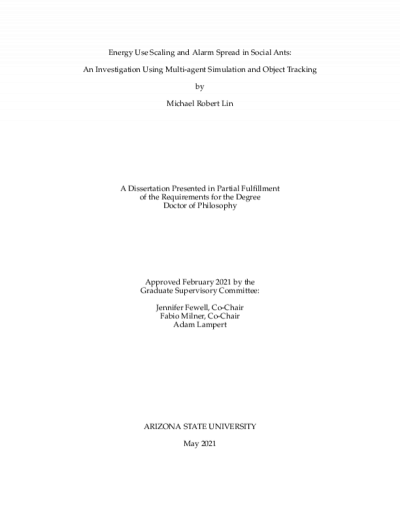
Description
Social insect groups, such as bees, termites, and ants, epitomize the emergence of group-level behaviors from the aggregated actions and interactions of individuals. Ants have the unique advantage that whole colonies can be observed in artificial, laboratory nests, and each individual's behavior can be continuously tracked using imaging software. In this dissertation, I study two group behaviors: (1) the spread of alarm signals from three agitated ants to a group of 61 quiescent nestmates, and (2) the reduction in per-capita energy use as colonies scale in size from tens of ants to thousands. For my first experiment, I track the motion of Pogonomyrmex californicus ants using an overhead camera, and I analyze how propagation of an initial alarm stimulus affects their walking speeds. I then build an agent-based model that simulates two-dimensional ant motion and the spread of the alarmed state. I find that implementing a simple set of rules for motion and alarm signal transmission reproduces the empirically observed speed dynamics. For the second experiment, I simulate social insect colony workers that collectively complete a set of tasks. By assuming that task switching is energetically costly, my model recovers a metabolic rate scaling pattern, known as hypometric metabolic scaling. This relationship, which predicts an organism's metabolic rate from its mass, is observed across a diverse set of social insect groups and animal species. The results suggest an explicit link between the degree of workers' task specialization and whole-colony energy use.
Details
Title
- Energy Use Scaling and Alarm Spread in Social Ants: An Investigation Using Multi-agent Simulation and Object Tracking
Contributors
- Lin, Michael Robert (Author)
- Milner, Fabio A (Thesis advisor, Committee member)
- Fewell, Jennifer H (Thesis advisor, Committee member)
- Lampert, Adam (Committee member)
- Arizona State University (Publisher)
Date Created
The date the item was original created (prior to any relationship with the ASU Digital Repositories.)
2021
Subjects
Resource Type
Collections this item is in
Note
- Partial requirement for: Ph.D., Arizona State University, 2021
- Field of study: Applied Mathematics for the Life and Social Sciences
